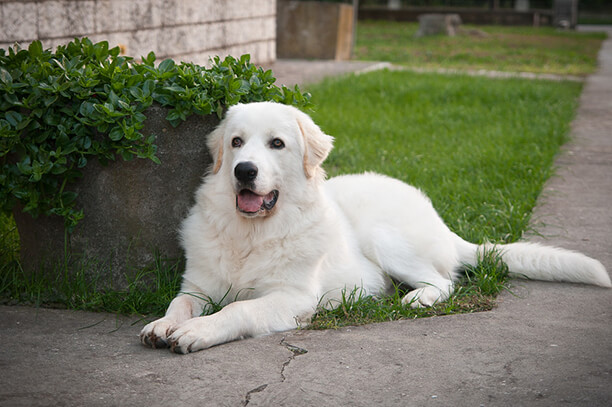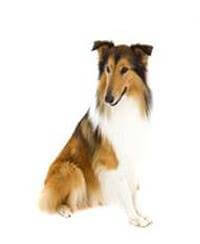Maremma Sheepdog breed overview
Thinking about adopting a Maremma Sheepdog? Check your local shelter first!
What makes Maremma Sheepdogs unique?
A Maremma Sheepdog grooming and hygiene needs
What are the health issues with Maremma dogs?
A Maremma Sheepdog behaviour and training needs
Can a Maremma be a house pet?
Do Maremma dogs bark a lot?
A Maremma Sheepdog’s mental and physical stimulation
A Maremma Sheepdog’s nutritional requirements
Do Maremma Sheepdogs make good family pets?
Maremma Sheepdog breeding and finding a responsible breeder
Final Thoughts
Maremma Sheepdog breed overview
Having been used as sheepdogs in Italy since the Roman era, the Maremma is an intelligent, independent, and loyal breed.
The Maremma sheepdog temperament is often characterised by a stubborn streak when they’re young, but with some firm and consistent training, these dogs can be an excellent family dog under the guidance of a dedicated pet parent who’s able to give them the attention they need.
The Maremma’s double coat stays healthy with moderate grooming, while regular brushing is useful for removing loose fur and preventing matting when they’re in their shedding season.
The Maremma Sheepdog lifespan is 11-12 years, and while they’re generally healthy, they’re prone to many of the same health issues as other dog breeds, such as hip dysplasia and hereditary eye disorders.

Thinking about adopting a Maremma Sheepdog? Check your local shelter first!
If you’re thinking about bringing a Maremma Sheepdog into your family, then why not consider adoption before you look at your options for buying from a breeder?
Aside from the knowledge that you’re giving a dog a home and helping shelters carry out their important work, dog adoption has a variety of other benefits to consider.
Some of the key benefits of adopting a Maremma include:
- Reduced costs and fees when compared to buying a dog from a breeder.
- Bringing a dog home that’s already had some level of house training.
- Having certain veterinary tasks already taken care of, such as microchipping and neutering.
- Adoption often means you’ll have greater choice in terms of ages, allowing you to choose a more mature dog if you have concerns about dealing with the puppy phase.
What makes Maremma Sheepdogs unique?
Maremmas are among the oldest working dog breeds in the world, with mentions of a similar white sheep dog from northern Italy being mentioned by Roman writers as early as 100 BC.
With such a rich heritage of guarding livestock, Maremmas are devoted and loyal to their family unit. This can manifest in some dogs being overly suspicious of strangers. However, like any dog, a Maremma Sheepdog temperament will depend on their training and picking up on your cues to adjust their behaviour to new people or animals.
Maremma dogs are double-coated, meaning they have a dense and fluffy undercoat and a sleeker, smoother topcoat. This provides ample insulation against the cold and helps Maremmas regulate their temperature in warmer conditions, allowing them to stay comfortable in a variety of weather.
The typical Maremma Sheepdog size places them firmly in the large breed category. Adult male Maremmas stand around 60 to 73cm tall, and weigh 30 to 45kg. A typical female Maremma Sheepdog size is 60 to 68cm tall, weighing 30 to 40kg. Their large stature and active nature means they should ideally be given lots of outdoor space to run around in between brisk walks.
Some similar breeds that share the Maremma’s size, herding intelligence and working instincts include:
A Maremma Sheepdog grooming and hygiene needs
The Maremma’s double coat should be groomed once a month or more to help keep them comfortable and in optimal health. This is especially important as Maremmas are double-coated, meaning that they tend to shed a lot and are more prone to matts and tangles due to hairs from the undercoat getting caught in the top coat.
As working dogs, Maremma dogs’ coats naturally repel dirt, and they don’t have to be bathed very often compared to some other breeds, helping reduce their dog grooming cost as part of your overall pet care expenses. However, occasional baths can help to loosen up the hairs of their coat and alleviate or reduce matting. Using a quality “shed control” conditioner during bathing will help keep your Maremma’s undercoat loose and reduce tangles.
Trimming your dog’s nails and cleaning their ears should also be done around once every few weeks to clear out some of the more stubborn dirt that gets into these areas during walks.
What are the health issues with Maremma dogs?
The Maremma Sheepdog lifespan is around 11-12 years, and they’re a generally healthy breed. However, they can suffer from health conditions that have the potential to affect all dogs, such as hip dysplasia and hereditary eye conditions. Regular check-ups with your vet can help with early detection and treatment of common health problems, and help you stay informed on good habits to maintain your dog’s health.
A Maremma Sheepdog behaviour and training needs
Maremmas are highly intelligent and certainly trainable. Having said that, the Maremma sheepdog temperament and their independent nature as working dogs and flock guardians can make them challenging for passive or inexperienced pet parents.
It’s important to use firm and consistent dog training from an early stage, backed by positive reinforcement such as giving your Maremma adult dog treats for good behaviour, which will help motivate them to listen and obey.
Maremmas are a markedly active breed, and pet parents may have to deal with common behavioural challenges like a habit to roam and bark at perceived threats. With the considerable Maremma Sheepdog size, it’s important to work on controlling these behaviours early to keep this defensive behaviour becoming a problem around new people.
Keeping your Maremma physically and mentally stimulated with regular exercise and interactive toys can help curtail these behaviours. It’s also important to train your dog to respond to a specific recall command if you’re planning to let them roam off the leash while on walks.
As a sheepdog with an inherent protective nature, socialisation is important for Maremmas to prevent excessive barking or other aggressive behaviour directed towards people and animals. Exposing your Maremma to a variety of people, and environments (while being careful not to overwhelm them!) will help them get used to new experiences and develop into well-adjusted pets.
Can a Maremma be a house pet?
Yes, Maremmas can be wonderful house pets with the right training and socialisation. Provided that the pet parent is able to give them effective, consistent training, and meet their needs for physical and mental stimulation, Maremmas can be perfectly happy and calm while living as house pets.
Do Maremma dogs bark a lot?
Having been bred to protect flocks from predators, many Maremmas are especially alert to perceived threats and can be prone to excessive barking. Early training and socialisation are important to reduce problem barking and ensure that Maremmas won’t disturb you or your neighbours.
A Maremma Sheepdog’s mental and physical stimulation
Like other working breeds, Maremmas are intelligent, active, and curious. Because of this, they’ll require plenty of exercise to ensure they get the physical and mental stimulation they crave. Brisk daily walks over varied terrain will help them blow off some steam, and so will regular playtime sessions in the garden.
When you’re not able to spend time with your dog in person, giving them access to interactive toys will prevent them from getting bored and restless.
New pet parents with busy schedules might ponder questions like “how long can you leave a dog alone?” when trying to plan out how they’ll schedule life around their new dog. This all depends on the specific dog’s temperament, how well they’ve been trained, and how much physical and mental stimulation they receive. When any dog is under-stimulated, it can lead to stress and frustration, increasing the likelihood of aggressive or destructive behaviours.
A Maremma Sheepdog’s nutritional requirements
As a large and active dog, it’s important to find a quality, nutritious dog food for your Maremma that’s specifically formulated for larger breeds. This will ensure your dog gets the appropriate levels of key nutrients necessary for all dogs’ health, including protein, carbohydrates, fats, vitamins, and minerals.
If your vet advises you that your Maremma is prone to certain health problems, for example digestion, immunity or joint issues, it may be helpful to supplement your dog’s diet with dog multivitamins.
Do Maremma Sheepdogs make good family pets?
The long Maremma Sheepdog lifespan of 11-12 years and their active, group-oriented personality makes them excellent family pets when they’re properly trained and socialised.
Their protective nature ranks Maremmas among the best family dogs around children, provided that they’re introduced to children at an early age. While they may have trouble with adults and children from outside the family unit, taking your Maremma out on walks where they’ll encounter different people, environments, and other dogs should help them acclimatise to new people and experiences.
As working dogs, Maremmas are known to do well with other animals too, especially livestock such as sheep and fowl. Their origin as sheepdogs not only makes them great family pets, but effective watchdogs for agricultural settings.
Maremma Sheepdog breeding and finding a responsible breeder
If you choose to buy a Maremma from a breeder rather than adopt one from a shelter, it’s important to find a breeder who adheres to responsible practices to ensure your dog’s temperament and overall wellbeing.
Some important things to consider when trying to find a good dog breeder include:
Researching Maremmas extensively so you know how to recognise signs of good temperament, health, and grooming.
Learning about how breeders’ health testing is conducted for Maremmas so you can review the information shared by the breeders.
Researching breeders to ensure they’re reputable in the local dog community and licensed with the relevant council.
Inquiring about early socialisation to ensure the puppies grow into well-adjusted adults.
Final Thoughts
If you’re planning on bringing a Maremma into your home, we hope this guide has given you a better idea of the breed’s unique characteristics, how to introduce them to their new environment, and how well they meet your wants and needs for a pet.
For more information on finding your ideal four-legged friend, be sure to check out our guides on dog adoption, and profiles on other dog breeds.






